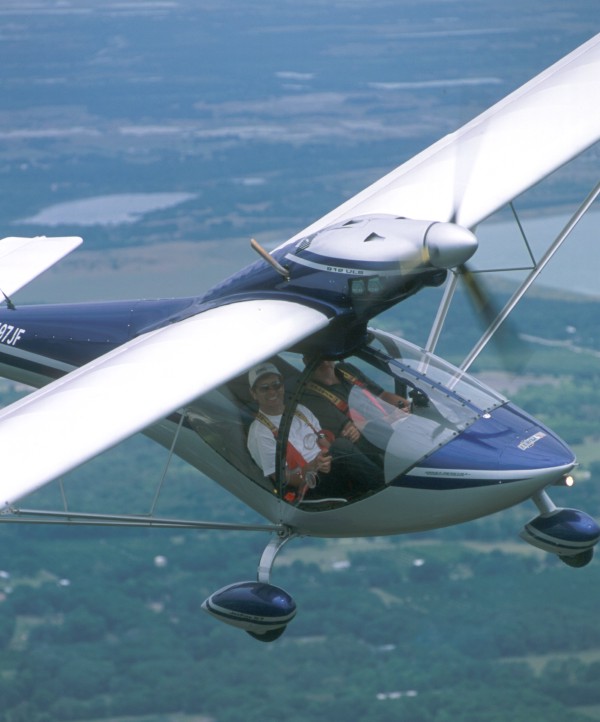
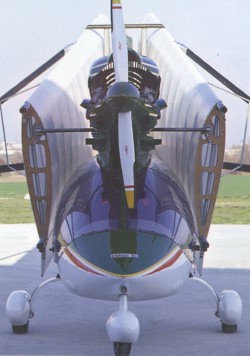
FOLD ‘EM – Though the process involves a few steps, the Jet Fox can fold its wings for compact storage.
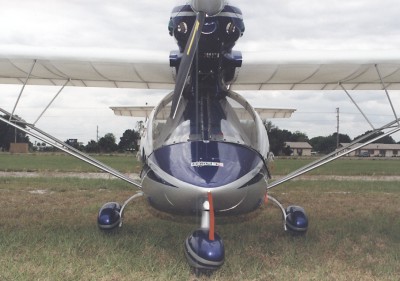
ALL CURVES – This Jet Fox 97 head-on photo reveals not only style but a smoothly-shaped exterior that produced a good performance and a quiet interior.
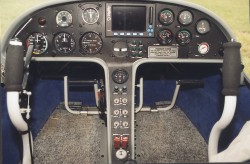
FULL PANEL – You don’t often see an ultralight panel this well loaded. The central Digifly-brand glass panel is for navigation; “steam gauges” give you flight and engine information.

PARACHUTE EQUIPPED – The “Danger” sign and the outline of an escape hatch plus the red handle inside shows Euro ALA chose to equip this plane with a ballistic parachute.
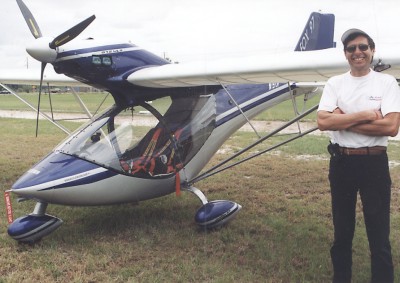
SERGIO THE PILOT – A smiling Italian name Sergio Cremonesi was more than pleased to show me Euro ALA’s elegant aircraft.

UNDER WRAPS – Euro ALA manages to completely enclose the Rotax 912 engine inside their sleek cowl. Here’s a peek underneath.
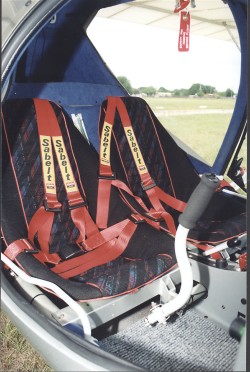
SECURE SEATING – Seats in the Jet Fox 97 proved comfortable and supportive. With secure restraint and a parachute, I felt well protected.

EVERY DETAIL – The nose fairing, wheel pant, and even the nose gear leg fairing show a great attention to detail, which serves both an aerodynamic and a visual purpose.
Sleek with curvaceous lines, the Jet Fox 97 commands attention, even when surrounded by other desirable flying machines. Welcome to Italian company Euro ALA and its candidate for the proposed Light-Sport Aircraft category. Sergio Cremonesi, the factory representative with whom I would fly the racing-looking Jet Fox 97, told me the “ALA” stood for Advanced Light Aircraft.
Advanced, indeed! I’d seen this machine in France at airshows in ’98 and ’99. I snapped photos of it and wherever I showed those pictures, ultralight pilots smiled with appreciation. In the finest Italian sense (think Ferrari), the Jet Fox 97 has the lines and looks to draw closer inspection.
One look inside – all Jet Fox 97s I’ve seen appear to be similarly outfitted – and those smiles morph into grins. The panel looks like something out of a fighter aircraft. A color flat glass display is flanked by the usual assortment of “steam gauges,” installed with engineering precision. All the engine dials lined up perfectly, and rows of lights and switches formed clearly labeled lines.
Sit in the Jet Fox 97 and the grins become giddy. This plane is full of appeal. Then we fly and it gets even better. Do you think I’m overstating things? Okay, factor in a rather sobering price of $40,000+ and fantasy meets reality| but it doesn’t tarnish the shine.
The Jet Fox 97 may be simply beyond the budget many pilots set for their flying fun machines. But it’s a great little light plane that I really enjoyed. And with a finance plan or a partner, well, maybe you could|
Italian Beauty on American Soil
As FAA moves toward some form of Light-Sport Aircraft rule and certification, the Jet Fox 97 may be one of the first to be viewed as a candidate aircraft.
In its response to FAA’s Sport Pilot/Light-Sport Aircraft NPRM, USUA has proposed a two-tiered approach to the proposed rule that makes a lot of sense to me and to many others (See “USUA Headquarters Report,” page 11 of this issue). If FAA’s proposal works, we’ll see the “fast glass” of the light set, those sleek all-composite aircraft that can slip through the air at 130+ mph. And we already have trikes, powered parachutes, plus many ultralights that were designed and built to fly more slowly. Given such a wide spectrum – and the equally different training needed to fly each – having two primary groups seems well considered.
The Jet Fox 97 bridges the two groups. Equip yours with less than seen in the photos here and it might fly closer to, say, a Flightstar. Load it up with the options allowed in a proposed 1,232-pound limit Light-Sport Aircraft and the Jet Fox 97 will fly more like the heavier aircraft it will become.
The Jet Fox 97 is a proven construction and a familiar shape taken to the limit. Pilots may embrace it enthusiastically. Given an empty weight over 600 pounds, you can see this isn’t the typical American 2-seat ultralight that weighs about 100 pounds less. However, like the also-weighty Air Cam, the Jet Fox 97 can fly in the realm ultralight pilots have come to treasure.
Yet some say this design represents “old technology,” that proposed Light-Sport Aircraft will be fiberglass or aluminum, often low-wing designs that are built for cross-country travel. While it’s true the faster tier of aircraft may boast more complex methods of construction, the covered-tubing style of ultralight aircraft is sure to persevere. It’s better known and is low cost to build. Not everyone will want a $60,000 fiberglass or aluminum speedster. Lots of pilots prefer the ultralight – and slower – realm of flight.
The Jet Fox 97 fits the fly-for-fun crowd well but in a deluxe fashion. So probably, it is priced right at halfway between current American ultralights and the Light-Sport Aircraft of tomorrow.
Regardless of your view of the future, the Jet Fox 97 is one fetching aircraft and looking at it isn’t nearly as good as flying it.
On the right side of the tapering aft fuselage is a fuel filler point and cap. On the opposite side is the exit hatch for the emergency parachute system. The hatch is a line of small, closely-spaced holes forming a perforation line that is covered with some thin accent tape. It appeared a workable system to me.
Though it may not appear so, the Jet Fox has folding wings. You first remove the horizontal tail plane by undoing clevis and safety pins, which incorporate a locking arrangement that assures you can’t reconnect incorrectly. Next, you loosen wing pins, pull the wing out, rotate it, and walk it back to the fuselage using the now removed tail plane attach points. Kolb and Kitfox may have faster wing fold mechanisms, but Euro ALA’s is functional. The truth is, the folding wing concept sells airplanes but most owners rarely fold.
Everyone notices the complete fairing for the standard 80-hp Rotax 912 engine (our test Jet Fox was fitted with a 100-hp Rotax 912S). Arguably the most distinctive feature of the design, it yields a form of sophistication not commonly seen on U.S. designs.
Formed in 1985 by Alfredo Di Cesare, a long-time ultralight enthusiast in Italy, ALA – without the “Euro” – first sold imported kits. In 1991, Di Cesare released the predecessor Jet Fox 91, which incorporated the best qualities he’d identified on the models he’d sold prior.
From its release in 1991, the Jet Fox played to a receptive pilot audience and managed to accumulate 140 sales in 3 years. In 1993, ALA also earned the German Gütesiegal (stamp of approval) and sales began to develop throughout Europe.
Over the years, the Jet Fox 91 received numerous enhancements. During these same years, the 80-hp Rotax 912 4-stroke engine began to attract greater interest from light aircraft buffs.
To incorporate the new larger engine and to meet steadily growing demand for the sleek ultralight, Di Cesare formed Euro ALA in 1995. Alfredo’s goal was to market a redesigned Jet Fox that could support the 4-stroke engine and appeal to the changing face of ultralight pilots in Europe. These aviators sought more features, more speed, more comfort, and they were willing to pay for it.
Within a couple of years, Di Cesare and his staff introduced the Jet Fox 97.
Our subject this month, the Jet Fox 97 took engine fairings to a new state of the art for the late 1990s. That enclosure of the 80-hp Rotax 912 not only looks smaller than many expected but it appears well executed with a jalousie-style series of vents on the rear and a movable cowl flap to help cooling.
The big fairing or cowling has an inlet just below the nose of the engine, which contains a radiator opening that isn’t easy to see. However, Euro ALA created a long radiator – running front to rear – that Sergio says is very effective for cooling. Indeed, I saw no high temperatures even though we were operating in rather warm, humid conditions.
From its smoothly faired nosewheel to the streamlined cabin to the cowled engine to the sloped tail cone, the Jet Fox 97 is a study in ambient airflow. Not only is the exterior well done, the cockpit is another source of joy.
Form and Function
Seated inside the cabin, looking up to the ceiling, one sees several controls. The left silver control is the choke, right silver control is trim, the left black control sets cabin heat temperature, the right knob regulates volume. Toward the front is the ballistic parachute handle and toward the rear is the flap handle with a finger-pull slide detent and three positions. At the back is a cowl flap that operates inside the engine cowling.
The Jet Fox 97’s cabin heat issues from outlets situated on either side of the instrument panel. The individual outlets can be aimed and adjusted for volume.
The center console also hosts a series of switches for electrical systems including: dual headphone volume knobs, cabin temperature switch, radio master, landing light, GPS unit (displayed on the big Digifly screen), fuel pressure, strobe, and two ignition switches with emergency shut-off hoods. Below all the switches is the key-locked engine start switch.
At the base of the panel, to the right of the turn coordinator, is a series of green lights, which confirm the operation of several of these electrical systems.
A distinctly European touch is the addition of a cigarette lighter. Americans may use such an outlet to power another GPS unit or a cell phone charger.
The throttle is placed in the wide-open position to ease entry and exit for the left-seat occupant. You pull it back once seated. The right seat occupant’s throttle is to the left of the center console.
Entry was simple though the doors, which open broadly, hinged as they are on the centerline of the windscreen. You back inside, seating yourself, and draw your legs in afterward. The doors instantly made it rather warm inside the cabin, but the vents cured that quickly once air began to flow past the cabin.
Control placement is convenient and the interior volume should handle two American-sized occupants quite comfortably. Exceptionally large pilots may feel somewhat squeezed.
You have two ways to tell fuel supply. One is a sight gauge – a marked section of clear tubing between the seat backs. The other is a conventional gauge on the panel, joining gauges for everything else imaginable.
Fuel capacity is a bit more than 55 liters (14.5 gallons) according to the markings, but the sight gauge only drops to 20 liters (5.3 gallons). When remaining fuel disappears from view, you should seek out a refill but you have close to an hour to work it out.
On the right side of the center console is a series of circuit breakers, which can all be verified from the right by a light pass of the finger. Any standing up, easily felt, are inoperative.
On the left side of the center console, a red handle can be seen. This is a battery disconnect switch which can be turned to the “off” position and then removed, preventing inadvertent start-up. Though unusual on American aircraft, European systems call for a different set of safety devices and this is one. (The Aquilair trike I flew the same day had a large, easily reached kill switch with a similar theme in mind, preventing possible injury.)
Rough Rider
This is such an impressive plane, I was on heightened watch for negative qualities. Every product has a drawback somewhere.
The Jet Fox felt quite firm on the ground, clearly reflecting the bumps of a sandy turf soil. The suspension was rather stiff and apparently better suited to hard surface runways. In taxi, the plane rattled rather loudly.
Most unfortunately, on Sergio’s return to the main Sun ‘n Fun ultralight runway – my evaluation flying had taken place at nearby South Lakeland Airpark – he experienced a collapse of the nose gear, which threw the beautiful Jet Fox upside down. Sergio wasn’t injured and damage to the Jet Fox was surprisingly light. Luckily, the event happened at a mere 25 mph, but apparently a broken axle bolt caused the wheel to jam tightly against the nosewheel fork, effectively slamming on the brakes at the nose. With its 100-hp Rotax 912S engine up high and sufficient forward motion, the Jet Fox rotated over. These things happen and I was pleased it hadn’t happened on my watch, but I was sorry to see such a gorgeous aircraft put temporarily out of commission. And I felt badly for Sergio, a most pleasant person.
Flashing back to South Lakeland, on my takeoff roll, I continued to experience the rough rattles. When the nosewheel lifted at rotation, some of this went away and the moment we became airborne, the Jet Fox 97 was instantly transformed to one of the smoothest aircraft I felt all week.
To and From Mother Earth
I asked Sergio for speed advice. He advised me to use 50 mph for rotation, 65 mph for best climb, and a 55-mph typical approach speed. With a stall a hair under 40 mph, approach could be made slower with practice. However, the Jet Fox seemed to find 55 mph by itself when two notches of flaps were deployed. The response was almost magical; I repeated it several times.
Since the Jet Fox finds a good approach speed easily, you can employ a superb side slip if you wish to steepen your descent. I was able to get the plane cocked almost 45° to either side in an approach that felt highly controllable. Being able to do this speaks to a powerful rudder and well-harmonized controls.
Sergio said the Jet Fox 97 has a glide angle of about 10:1, a figure I have no trouble believing after making several approaches to landing.
I tended to come in high almost every time, which confirms the good glide and modest descent rate of the Jet Fox 97. She may be rather heavy empty (612 pounds) but the wings are obviously sized right, at least at proper speeds.
Brakes on the joystick are not particularly strong, but slowed me adequately on a long grass runway and would certainly add stopping power for hard-surface operations. Hydraulic brakes are available for those who need more.
All controls use push-pull cable systems including the rudder. In my experience this made for very smooth control actions. I found the Jet Fox to be a very pleasant plane. All controls are very cooperative.
The Jet Fox 97 has a very powerful rudder; mere taps of the pedals really yaw the plane noticeably. This can be seen demonstrably as it slips to a landing.
It’s worth noting that the windshield did not deform at any time, even when Sergio demonstrated 45° angled flight aloft and at speed. On the whole, the Jet Fox 97 felt very solid and secure aloft.
In Its Element
High-speed cruise at full throttle hit 100 mph, though we were also able to operate easily at 50 mph without flaps and the Jet Fox flew well at both speeds.
We did not use the Digifly for this evaluation as it is intended for navigation needs. As an afterthought, perhaps we should have flipped it on to crosscheck the ASI. I have used this navigation instrument before and it has a clear readout.
The engine and cockpit were quiet enough that we didn’t wear either headsets or earplugs and were able to converse in flight. I was easily able to make recorded notes in flight and this is not common during many evaluations due to the noise level. Nonetheless, I still prefer to employ ear protection.
Of course, fuel consumption was as good as Rotax 912 pilots have come to expect. Given the 14.5 gallons on board, the Jet Fox 97 should be able to sustain better than 4 hours at modest cruise speeds (assuming the pilot’s personal plumbing is up to such long flights).
All stalls were very mild. I performed power-on, power-off, and accelerated stalls. The accelerated stall merely rolled level though I only did the maneuver to the left.
Base kit price for the Jet Fox 97 is $25,600 and I looked at no kit parts nor manuals to be any judge of the work effort. Even if the parts fit easily, you’ll spend time in the detail of that instrument panel and center console.
Euro ALA U.S.A. lists the Rotax 912 series of engines for very good prices if you select them with the kit purchase. Call for more details but they are offering a good bargain.
Options you may want include wheel pants ($346), special interior finishings ($159), emergency parachute (about $3,000), folding wings ($1,270), strobe lights (3 of them for $547), landing light ($50), internal heat system ($547), and hydraulic brakes ($650).
The superbly equipped Jet Fox that I test-flew sells for $42,000 to $44,000, depending on final selection of items. That number may be high for American sensibilities, but consider that the plane was both fully built and equipped with lots of features and goodies.
It may set you back a bit further than some other choices (yet be less than some proposed future Light-Sport Aircraft), but I predict you could find true happiness with this Italian beauty.
| Seating | 2, side-by-side |
| Empty weight | 612 pounds |
| Gross weight | 1,230 pounds 1 |
| Wingspan | 32.25 feet |
| Wing area | 157 square feet |
| Wing loading | 7.8 pounds per square foot 1 |
| Length | 18.5 feet |
| Height | 10 feet |
| Kit type | Fully assembled or kit 2 |
| Build time | Not determined |
| Notes: | 1 Weight established for Light-Sport Aircraft proposal; flown as an ultralight/microlight in Europe at 990 pounds – wing loading then 6.3 pounds per square foot. 2 Kit manuals not examined. |
| Standard engine | Rotax 912 |
| Power | 80 hp |
| Power loading | 15.2 pounds per hp 3 |
| Cruise speed | 50-90 mph |
| Never exceed speed | 115 mph |
| Rate of climb at gross | 1,200 fpm |
| Takeoff distance at gross | 330 feet |
| Landing distance at gross | 400 feet |
| Notes: | 3 Assuming weight under proposed Light-Sport Aircraft category; when flown as an ultralight/microlight in Europe power loading is 12.3 pounds per hp. |
| Standard Features | 80-hp Rotax 912, electric starting, fully enclosed cabin with dual doors, dual controls, mechanical flaps, in-flight trim, remote choke, safety battery shut-off, brakes, Trilam wing coverings. |
| Options | Hydraulic brakes, 100-hp Rotax 912S, full instrumentation, cabin heating system, wheel pants, folding wing system, emergency parachute, strobe lights, electrical flaps. |
| Construction | Aluminum airframe, steel components, fiberglass fairing, Dacron and Trilam wing and tail coverings. Made in Italy with Miami, Florida-based representation. |
Design
Cosmetic appearance, structural integrity, achievement of design goals, effectiveness of aerodynamics, ergonomics.
Pros – Sleek looks. Second-generation design (first was the Jet Fox 91) from an Italian company with 17 years experience in ultralights. Should conform to proposed Light-Sport Aircraft category, though generally operates like most U.S. ultralights. Superbly equipped. Has received German certification.
Cons – Somewhat “dated” design compared to many all-composite Euro sport planes (though Americans may not see it as old). Higher empty weight than U.S. buyers expect.
Systems
Subsystems available to pilot such as: Flaps; Fuel sources; Electric start; In-air restart; Brakes; Engine controls; Navigations; Radio; (items covered may be optional).
Pros – Loaded with extras – especially on test plane. Flaps, trim, electric starting, remote choke, cabin heat, battery disconnect, brakes, an emergency parachute system, and even a landing light were all included. Flaps were impressive in operation and function.
Cons – Lots of fancy systems drive up the price, no way around it. Did not use the Digifly navigation system; same for cabin heat. Repair work to the engine requires removal of the large cowling and inspecting the covered airframe is more time-consuming than an open ultralight.
Cockpit/Cabin
Instrumentation; Ergonomics of controls; Creature comforts; (items covered may be optional).
Pros – Comfortable and spacious cabin. Unusually quiet – rare in ultralights to not need ear protection and I could still make conversation (though I always prefer to have ear protection). Entry/exit were quite easy thanks to wide doors that hinge on a center line. Small cargo area available.
Cons – Pistons that hold the doors during entry/exit were not installed ($36 option). No seat or rudder pedal adjustments for differing pilot height. Door latches were a bit tricky to get solidly latched. No other negatives.
Ground Handling
Taxi visibility; Steering; Turn radius; Shock absorption; Stance/Stability; Braking.
Pros – Precise steering available through dual rudder pedals. Turn radius was quite small. Enormous visibility (except directly overhead, of course). Greater empty weight gave a secure feeling in wind. Main gear leg is slab-style and looks very robust.
Cons – The Jet Fox 97 felt rough on a sandy turf taxiway and runway; rattled significantly. Some vulnerability in the event of an off-field landing due to modest ground clearance.
Takeoff/Landing
Qualities; Efficiency; Ease; Comparative values.
Pros – Pull two notches of flaps and the Jet Fox seems to automatically go to 55 mph, perfect for a normal approach. Good glide angle, quoted at 10:1 from factory rep. Superb slipping capability. Very good crosswind capability. Visibility on takeoff is good; excellent on landing.
Cons – Heavier empty weight and higher wing loading make for longer takeoff roll – though landings can be relatively short once you learn to make good use of flaps and slips. Not as strong on short/soft-field takeoffs. Bumpy ride prior to rotation.
Control
Quality and quantity for: Coordination; Authority; Pressures; Response; and Coupling.
Pros – Extremely powerful rudder, as strong as any I’ve flown (makes for deep slip potential). Reasonable control harmony between ailerons and rudder. Pitch felt comfortably dampened. Dutch rolls went well and precision turns to heading were simple.
Cons – If anything, the rudder may overpower the ailerons (opposite of many designs). No other negatives discovered.
Performance
Climb; Glide; Sink; Cruise/stall/max speeds; Endurance; Range; Maneuverability.
Pros – Instantly smooth at takeoff (a pleasant change from the ground chatter). Strong climb. Good cruise at about 85-100 mph makes for good cross-country performance. Unusually quiet cabin environment. Flies well at 45 mph with flaps deployed. Slow flight was effortless with good control.
Cons – Speed range is somewhat limited compared to other designs; stall at about 40 ranging to max cruise at 100 is a 2.5 multiple (4:1 is the Holy Grail of design). Doesn’t slow well for those who prefer low-over-the-field flying.
Stability
Stall recovery and characteristics; Dampening; Spiral stability; Adverse yaw qualities.
Pros – Power-on, power-off, and accelerated stalls were all very benign with no tendency to fall off on a wing. Four-point seat belts on both seats are standard. Emergency ballistic parachute was appreciated. Held steep turns with little pilot input; carved very clean turns. Very hands-off stable.
Cons – Stalls at around 40 mph are higher than very light ultralights. The high-mounted and powerful engine creates the expected pitchover on power-up, opposite of certified designs (though it wasn’t radical thanks to a powerful tailplane).
Overall
Addresses the questions: “Will a buyer get what he/she expects to buy, and did the designer/builder achieve the chosen goal?”
Pros – Italian sense of finish with beautiful glass work; as sharp as you’ll see and very well equipped. The Jet Fox was my 2002 airshow “Pick-of-the-Week” among 14 aircraft flown. Delivers a very nice experience to one or two occupants (as long as they aren’t both extremely large).
Cons – Quite costly compared to many American designs (though closer if both equipped this well). No information on kit manual and language differences could make this challenging. No info on delivery times.


Leave a Reply